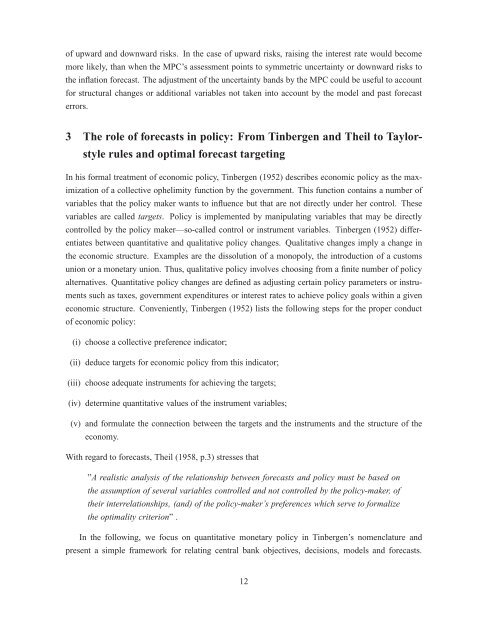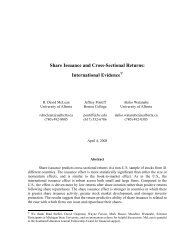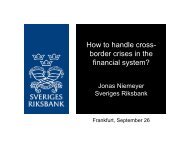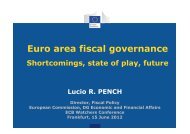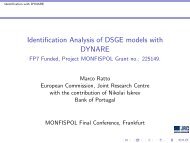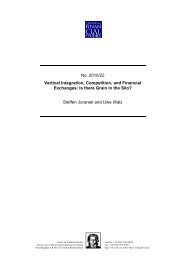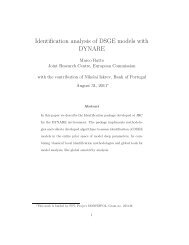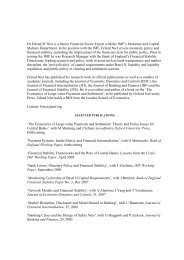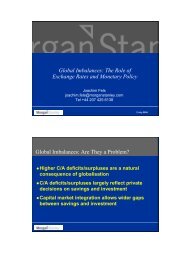Forecasting and Policy Making (Paper) - Center for Financial Studies
Forecasting and Policy Making (Paper) - Center for Financial Studies
Forecasting and Policy Making (Paper) - Center for Financial Studies
You also want an ePaper? Increase the reach of your titles
YUMPU automatically turns print PDFs into web optimized ePapers that Google loves.
of upward <strong>and</strong> downward risks. In the case of upward risks, raising the interest rate would become<br />
more likely, than when the MPC’s assessment points to symmetric uncertainty or downward risks to<br />
the inflation <strong>for</strong>ecast. The adjustment of the uncertainty b<strong>and</strong>s by the MPC could be useful to account<br />
<strong>for</strong> structural changes or additional variables not taken into account by the model <strong>and</strong> past <strong>for</strong>ecast<br />
errors.<br />
3 The role of <strong>for</strong>ecasts in policy: From Tinbergen <strong>and</strong> Theil to Taylor-<br />
style rules <strong>and</strong> optimal <strong>for</strong>ecast targeting<br />
In his <strong>for</strong>mal treatment of economic policy, Tinbergen (1952) describes economic policy as the max-<br />
imization of a collective ophelimity function by the government. This function contains a number of<br />
variables that the policy maker wants to influence but that are not directly under her control. These<br />
variables are called targets. <strong>Policy</strong> is implemented by manipulating variables that may be directly<br />
controlled by the policy maker—so-called control or instrument variables. Tinbergen (1952) differ-<br />
entiates between quantitative <strong>and</strong> qualitative policy changes. Qualitative changes imply a change in<br />
the economic structure. Examples are the dissolution of a monopoly, the introduction of a customs<br />
union or a monetary union. Thus, qualitative policy involves choosing from a finite number of policy<br />
alternatives. Quantitative policy changes are defined as adjusting certain policy parameters or instru-<br />
ments such as taxes, government expenditures or interest rates to achieve policy goals within a given<br />
economic structure. Conveniently, Tinbergen (1952) lists the following steps <strong>for</strong> the proper conduct<br />
of economic policy:<br />
(i) choose a collective preference indicator;<br />
(ii) deduce targets <strong>for</strong> economic policy from this indicator;<br />
(iii) choose adequate instruments <strong>for</strong> achieving the targets;<br />
(iv) determine quantitative values of the instrument variables;<br />
(v) <strong>and</strong> <strong>for</strong>mulate the connection between the targets <strong>and</strong> the instruments <strong>and</strong> the structure of the<br />
economy.<br />
With regard to <strong>for</strong>ecasts, Theil (1958, p.3) stresses that<br />
”A realistic analysis of the relationship between <strong>for</strong>ecasts <strong>and</strong> policy must be based on<br />
the assumption of several variables controlled <strong>and</strong> not controlled by the policy-maker, of<br />
their interrelationships, (<strong>and</strong>) of the policy-maker’s preferences which serve to <strong>for</strong>malize<br />
the optimality criterion” .<br />
In the following, we focus on quantitative monetary policy in Tinbergen’s nomenclature <strong>and</strong><br />
present a simple framework <strong>for</strong> relating central bank objectives, decisions, models <strong>and</strong> <strong>for</strong>ecasts.<br />
12


